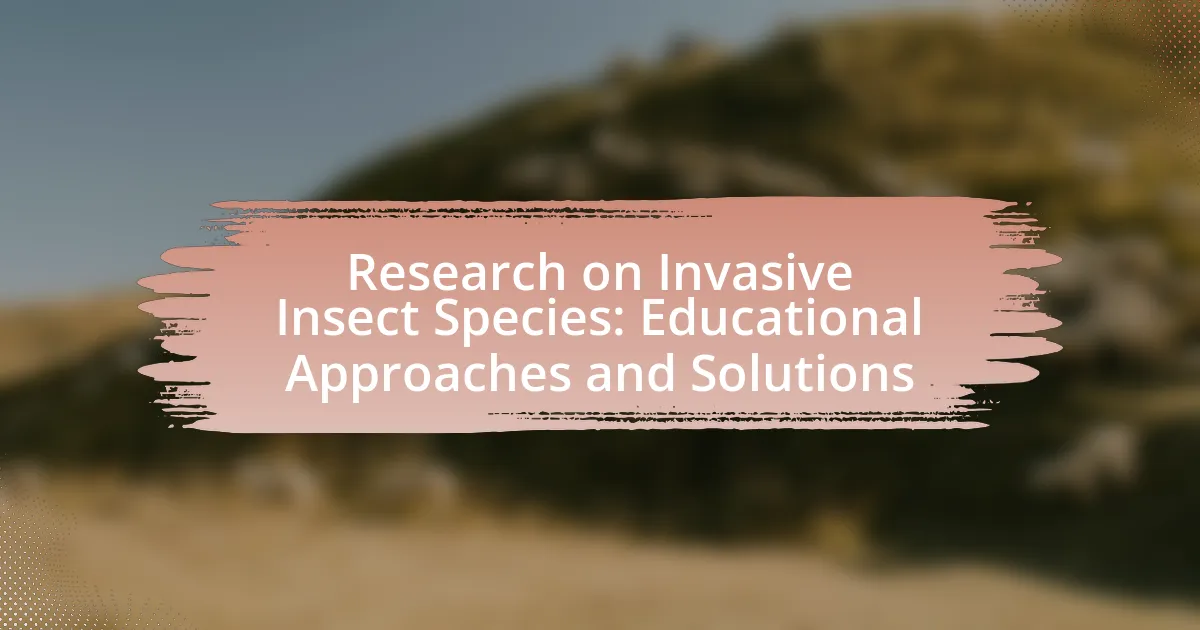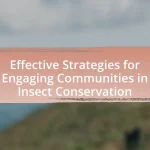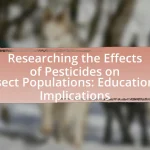The article focuses on invasive insect species, which are non-native insects that cause significant harm to ecosystems, economies, and human health upon introduction to new environments. It explores the ecological impacts of these species, such as biodiversity loss and disruption of food webs, with specific examples like the emerald ash borer. The article emphasizes the importance of research in understanding these impacts and developing effective management strategies, including biological, chemical, and cultural control methods. Additionally, it discusses educational approaches for raising public awareness and community engagement in managing invasive species, highlighting the role of technology and data collection in these efforts.
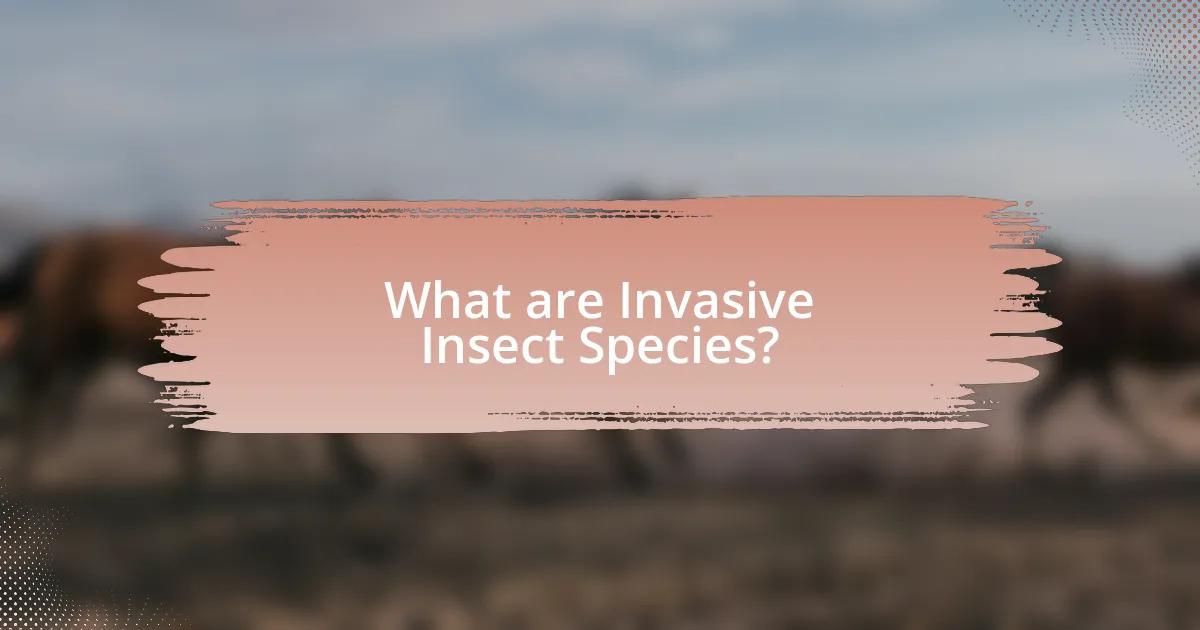
What are Invasive Insect Species?
Invasive insect species are non-native insects that, when introduced to a new environment, cause significant harm to the ecosystem, economy, or human health. These species often outcompete native insects for resources, disrupt food chains, and can lead to the decline or extinction of native species. For example, the emerald ash borer, an invasive beetle from Asia, has devastated ash tree populations in North America, resulting in substantial ecological and economic impacts.
How do invasive insect species impact ecosystems?
Invasive insect species significantly disrupt ecosystems by outcompeting native species for resources, altering food webs, and introducing diseases. For instance, the emerald ash borer, an invasive beetle, has decimated ash tree populations in North America, leading to a decline in species that depend on these trees for habitat and food. This disruption can result in reduced biodiversity, as native species struggle to survive in altered environments. Additionally, invasive insects can change nutrient cycling and soil composition, further impacting plant communities and the overall health of ecosystems.
What are the ecological consequences of invasive insects?
Invasive insects disrupt local ecosystems, leading to biodiversity loss and altered food webs. These species often outcompete native insects for resources, resulting in declines of native populations. For example, the introduction of the emerald ash borer has devastated ash tree populations in North America, which in turn affects species that rely on these trees for habitat and food. Additionally, invasive insects can introduce new diseases to native species, further threatening their survival. The ecological consequences are profound, as they can lead to shifts in species composition and ecosystem functions, ultimately destabilizing the affected environments.
How do invasive insects affect native species?
Invasive insects negatively impact native species by outcompeting them for resources, disrupting ecosystems, and introducing diseases. For example, the emerald ash borer, an invasive beetle, has decimated ash tree populations in North America, leading to significant declines in species that depend on these trees for habitat and food. Studies indicate that invasive insects can reduce native biodiversity by up to 50%, as they often lack natural predators in their new environments, allowing their populations to grow unchecked. This competitive advantage can lead to the extinction of native species and alter the structure of local ecosystems.
Why is research on invasive insect species important?
Research on invasive insect species is important because it helps to understand their ecological impact and informs management strategies. Invasive insects can disrupt local ecosystems, outcompete native species, and cause significant economic damage; for instance, the emerald ash borer has led to the loss of millions of ash trees in North America, costing billions in removal and replacement. By studying these species, researchers can develop effective control measures and policies to mitigate their negative effects, ultimately protecting biodiversity and economic interests.
What role does research play in managing invasive species?
Research plays a critical role in managing invasive species by providing essential data on their biology, ecology, and impacts on native ecosystems. This information enables the development of effective management strategies, such as targeted control measures and prevention protocols. For instance, studies have shown that understanding the reproductive habits and dispersal mechanisms of invasive species can inform the timing and methods of interventions, leading to more successful eradication efforts. Additionally, research helps identify vulnerable ecosystems and species, allowing for prioritized conservation efforts. Overall, the integration of scientific findings into management practices is vital for mitigating the negative effects of invasive species on biodiversity and ecosystem health.
How can research inform policy and public awareness?
Research can inform policy and public awareness by providing evidence-based insights that guide decision-making and enhance understanding of invasive insect species. For instance, studies such as “The Economic Impact of Invasive Species” published in the journal Biological Invasions demonstrate how data on the ecological and economic effects of invasive insects can lead to the development of effective management policies. Additionally, research findings can be disseminated through public awareness campaigns, as seen in the “Stop Invasive Species” initiative, which utilizes scientific data to educate communities about prevention and control measures. This integration of research into policy and public outreach ensures that strategies are grounded in scientific evidence, ultimately leading to more effective responses to invasive species challenges.
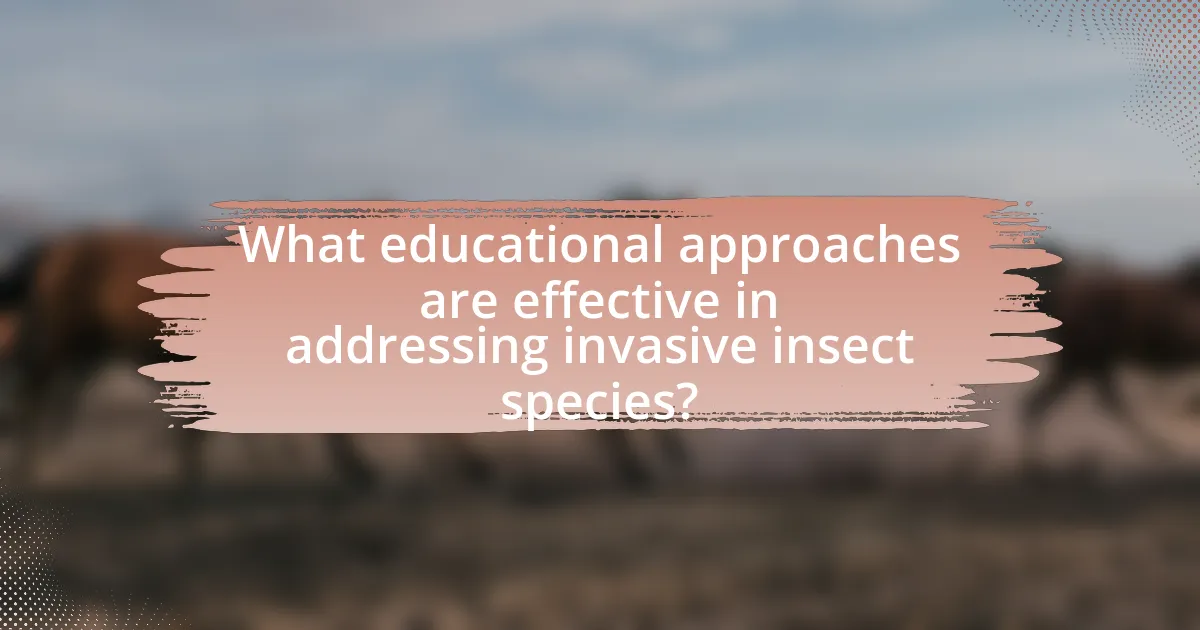
What educational approaches are effective in addressing invasive insect species?
Effective educational approaches for addressing invasive insect species include community engagement programs, integrated pest management (IPM) training, and the use of digital platforms for awareness campaigns. Community engagement programs foster local participation in monitoring and managing invasive species, which has been shown to increase public awareness and action. IPM training equips individuals with knowledge on sustainable practices to control invasive insects while minimizing environmental impact. Digital platforms, such as social media and mobile applications, facilitate the dissemination of information and real-time reporting of invasive species sightings, enhancing community response efforts. These approaches have been validated by studies indicating that informed communities are more proactive in managing invasive species, leading to better ecological outcomes.
How can schools incorporate invasive insect education into their curriculum?
Schools can incorporate invasive insect education into their curriculum by integrating hands-on activities, interdisciplinary lessons, and community involvement. For instance, educators can develop science units that focus on the biology, ecology, and impact of invasive species, using local examples to make the content relevant. Additionally, schools can partner with local environmental organizations to provide field trips or guest speakers who specialize in invasive species management. Research indicates that experiential learning, such as monitoring local ecosystems for invasive insects, enhances student engagement and understanding (National Science Teaching Association, 2020). By utilizing these strategies, schools can effectively educate students about the significance of invasive insects and their ecological consequences.
What subjects are most relevant for teaching about invasive insects?
Biology, ecology, and environmental science are the most relevant subjects for teaching about invasive insects. Biology provides foundational knowledge about insect anatomy, physiology, and life cycles, which is essential for understanding how invasive species interact with native ecosystems. Ecology focuses on the relationships between organisms and their environments, highlighting the impact of invasive insects on biodiversity and ecosystem functions. Environmental science addresses the broader implications of invasive species on habitats, conservation efforts, and management strategies, emphasizing the importance of interdisciplinary approaches in tackling the challenges posed by invasive insects.
How can hands-on activities enhance learning about invasive species?
Hands-on activities enhance learning about invasive species by providing experiential learning opportunities that engage students actively in the subject matter. Engaging in practical tasks, such as field studies or laboratory experiments, allows learners to observe the behaviors and impacts of invasive species firsthand, fostering a deeper understanding of ecological dynamics. Research indicates that experiential learning can improve retention of information; for instance, a study published in the Journal of Environmental Education found that students who participated in hands-on activities demonstrated a 30% increase in knowledge retention compared to traditional lecture-based learning. This active involvement not only reinforces theoretical concepts but also cultivates critical thinking and problem-solving skills essential for addressing real-world environmental challenges.
What role do community programs play in educating the public?
Community programs play a crucial role in educating the public by providing accessible information and resources about invasive insect species. These programs often involve workshops, seminars, and hands-on activities that engage community members in learning about the ecological impacts of invasive species and effective management strategies. For instance, the University of Florida’s Institute of Food and Agricultural Sciences has implemented community outreach initiatives that have successfully increased awareness and understanding of invasive species among local populations, leading to more informed decision-making and participation in control efforts. Such educational efforts are essential for fostering community involvement and promoting sustainable practices to mitigate the effects of invasive insects.
How can local organizations raise awareness about invasive insects?
Local organizations can raise awareness about invasive insects by implementing community education programs and outreach initiatives. These programs can include workshops, informational seminars, and distribution of educational materials that detail the impact of invasive species on local ecosystems. For instance, the U.S. Forest Service reports that invasive insects can cause significant economic damage, costing billions annually in management and control efforts. By collaborating with schools, local governments, and environmental groups, organizations can effectively disseminate information and engage the public in monitoring and reporting invasive species sightings.
What strategies can be used to engage the community in invasive species management?
Community engagement in invasive species management can be effectively achieved through educational outreach programs, volunteer initiatives, and collaboration with local organizations. Educational outreach programs, such as workshops and informational sessions, raise awareness about the impacts of invasive species and promote best management practices. Volunteer initiatives, like community clean-up days and invasive species removal events, encourage active participation and foster a sense of ownership among community members. Collaboration with local organizations, including schools, environmental groups, and government agencies, enhances resource sharing and amplifies outreach efforts, leading to a more informed and engaged public. These strategies have been shown to increase community involvement and improve management outcomes, as evidenced by successful case studies in various regions where local participation significantly reduced invasive species populations.
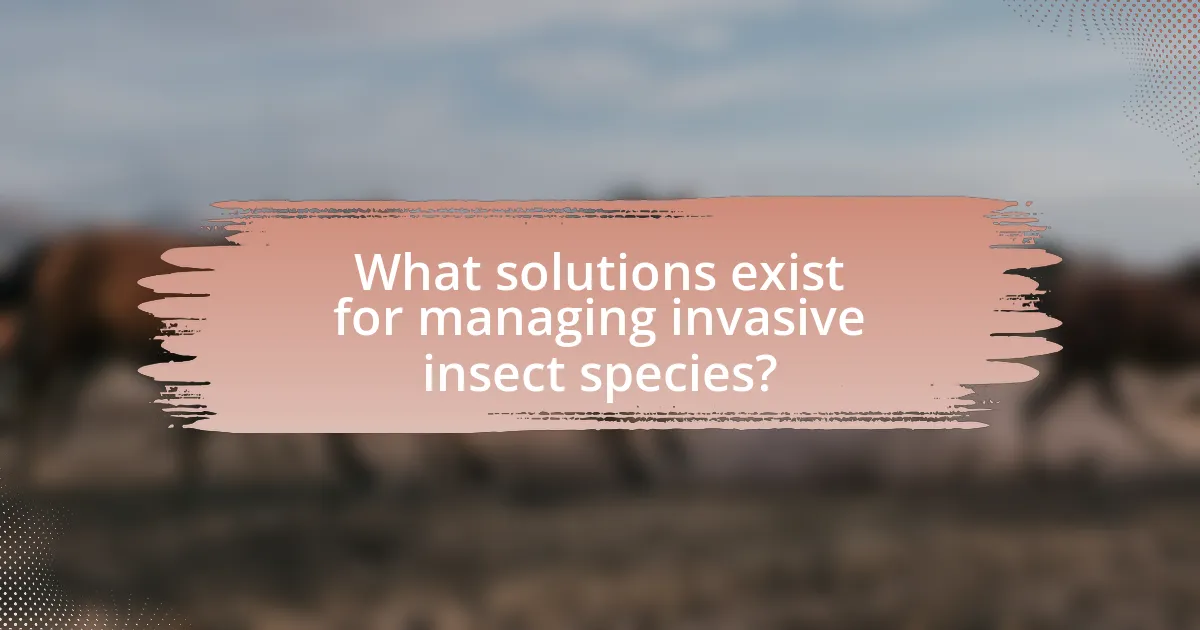
What solutions exist for managing invasive insect species?
Solutions for managing invasive insect species include biological control, chemical control, cultural practices, and regulatory measures. Biological control involves introducing natural predators or parasites to reduce invasive populations, as seen with the use of the parasitoid wasp to control the emerald ash borer in North America. Chemical control utilizes pesticides to eliminate invasive species, although this method requires careful application to minimize environmental impact. Cultural practices, such as crop rotation and habitat management, can help prevent the establishment of invasive insects by promoting biodiversity and ecosystem resilience. Regulatory measures, including quarantine protocols and import restrictions, aim to prevent the introduction and spread of invasive species, supported by the International Plant Protection Convention guidelines. These strategies collectively contribute to effective management of invasive insect populations.
What are the most common methods for controlling invasive insects?
The most common methods for controlling invasive insects include biological control, chemical control, cultural control, and mechanical control. Biological control involves using natural predators or parasites to reduce insect populations, such as introducing ladybugs to control aphids. Chemical control employs pesticides to eliminate invasive species, with specific examples including neonicotinoids targeting certain pests. Cultural control focuses on altering farming practices to make environments less conducive to invasive insects, such as crop rotation and sanitation measures. Mechanical control utilizes physical methods, like traps or barriers, to prevent or reduce insect infestations. These methods are widely recognized in entomological research and pest management practices, demonstrating their effectiveness in managing invasive insect populations.
How effective are biological control methods?
Biological control methods are highly effective in managing invasive insect species. Research indicates that these methods can significantly reduce pest populations, often achieving control rates of 80% or more in certain cases. For instance, the introduction of natural predators, such as parasitoids and predators, has been documented to successfully suppress populations of invasive pests like the emerald ash borer. Studies show that biological control not only reduces the need for chemical pesticides but also promotes ecological balance, enhancing biodiversity.
What are the pros and cons of chemical control methods?
Chemical control methods offer effective pest management by rapidly reducing invasive insect populations, but they also pose significant risks to non-target species and the environment. The primary advantage of chemical control is its ability to quickly eliminate pests, which can prevent crop damage and economic loss; for instance, studies have shown that insecticides can reduce pest populations by over 90% in agricultural settings. However, the disadvantages include potential harm to beneficial insects, such as pollinators, and the development of pesticide resistance among target species, which can lead to increased application rates and environmental contamination. Additionally, chemical residues can persist in ecosystems, affecting soil health and water quality, as evidenced by research indicating that certain pesticides can remain in the environment for months or even years.
How can technology aid in the management of invasive insect species?
Technology aids in the management of invasive insect species through advanced monitoring, data analysis, and control methods. For instance, remote sensing technologies, such as drones and satellite imagery, enable researchers to track the spread of invasive species in real-time, allowing for timely interventions. Additionally, machine learning algorithms analyze ecological data to predict invasion patterns and assess the effectiveness of management strategies. Furthermore, genetic technologies, like CRISPR, offer potential solutions for controlling populations by altering reproductive capabilities. These technological advancements enhance the efficiency and effectiveness of invasive species management, as evidenced by studies showing significant reductions in pest populations when integrated pest management systems utilize these tools.
What role does data collection play in invasive species management?
Data collection is essential in invasive species management as it provides the necessary information to identify, monitor, and control invasive species effectively. Accurate data enables researchers and managers to assess the distribution, population dynamics, and ecological impacts of invasive species, which is crucial for developing targeted management strategies. For instance, studies have shown that data-driven approaches can lead to a 50% reduction in the spread of invasive species when management actions are informed by comprehensive ecological data. This evidence underscores the importance of systematic data collection in formulating effective responses to invasive species threats.
How can mobile applications assist in tracking invasive insects?
Mobile applications can assist in tracking invasive insects by enabling real-time data collection and sharing among users, researchers, and authorities. These applications often utilize GPS technology to allow users to report sightings, which can be aggregated to create maps of invasive species distribution. For instance, platforms like iNaturalist and EDDMapS have been effective in documenting invasive species occurrences, providing valuable data for ecological studies and management strategies. Research indicates that citizen science initiatives, facilitated by mobile apps, significantly enhance the volume of data collected, leading to more informed decision-making in pest management (Silvertown, 2009, “A New Dawn for Citizen Science”).
What best practices should be followed in managing invasive insect species?
Best practices for managing invasive insect species include early detection, rapid response, and public education. Early detection allows for timely intervention, which is crucial in preventing the establishment and spread of invasive species. Rapid response involves implementing control measures as soon as an invasive species is identified, which can significantly reduce its impact. Public education raises awareness about the risks associated with invasive insects and encourages community involvement in monitoring and reporting sightings. Research indicates that programs combining these strategies can effectively manage invasive species, as demonstrated by successful case studies in various regions.
How can individuals contribute to invasive species management?
Individuals can contribute to invasive species management by participating in local removal efforts and educating themselves and others about invasive species. Engaging in community clean-up events helps remove invasive plants and animals, thereby reducing their spread. Additionally, individuals can promote awareness by sharing information on the ecological impacts of invasive species through social media or community workshops. Research indicates that community involvement significantly enhances the effectiveness of invasive species management programs, as seen in initiatives like the “Pulling Together” program, which has successfully mobilized volunteers to combat invasive species in various regions.
What resources are available for further education on invasive insects?
Resources for further education on invasive insects include academic journals, government publications, and online courses. Academic journals such as “Biological Invasions” and “Invasive Plant Science and Management” provide peer-reviewed research articles on invasive species. Government publications from agencies like the U.S. Department of Agriculture and the Environmental Protection Agency offer guidelines and management strategies. Online platforms like Coursera and edX feature courses on ecology and invasive species management, allowing learners to access expert knowledge and case studies. These resources collectively enhance understanding and management of invasive insects through credible and structured information.
